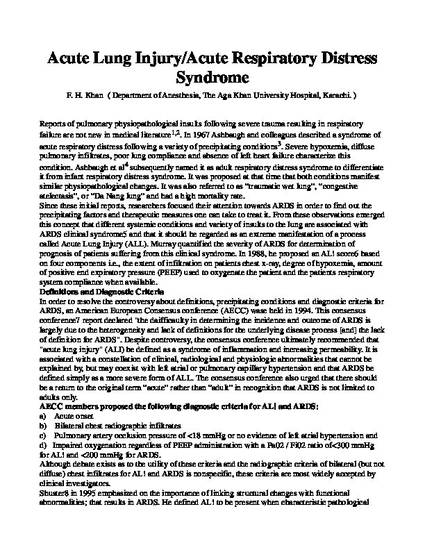
Article
Acute lung injury/acute respiratory distress syndrome
Journal of Pakistan Medical Association
Publication Date
1-1-2002
Document Type
Article
Disciplines
Abstract
Reports of pulmonary physiopathological insults following severe trauma resulting in respiratory failure are not new in medical literature1,2. In 1967 Ashbaugh and colleagues described a syndrome of acute respiratory distress following a variety of precipitating conditions3. Severe hypoxemia, diffuse pulmonary infiltrates, poor lung compliance and absence of left heart failure characterize this condition. Ashbaugh et al4 subsequently named it as adult respiratory distress syndrome to differentiate it from infant respiratory distress syndrome. It was proposed at that time that both conditions manifest similar physiopathological changes. It was also referred to as “traumatic wet lung”, “congestive atelectasis”, or “Da Nang lung” and had a high mortality rate. Since these initial reports, researchers focused their attention towards ARDS in order to find out the precipitating factors and therapeutic measures one can take to treat it. From these observations emerged this concept that different systemic conditions and variety of insults to the lung are associated with ARDS clinical syndrome5 and that it should be regarded as an extreme manifestation of a process called Acute Lung Injury (ALL). Murray quantified the severity of ARDS for determination of prognosis of patients suffering from this clinical syndrome. In 1988, he proposed an AL! score6 based on four components i.e., the extent of infiltration on patients chest x-ray, degree of hypoxemia, amount of positive end expiratory pressure (PEEP) used to oxygenate the patient and the patients respiratory system compliance when available.
Citation Information
Fazal Hameed Khan. "Acute lung injury/acute respiratory distress syndrome" Journal of Pakistan Medical Association Vol. 52 Iss. 7 (2002) p. 323 - 328 Available at: http://works.bepress.com/fazal_hameed/3/